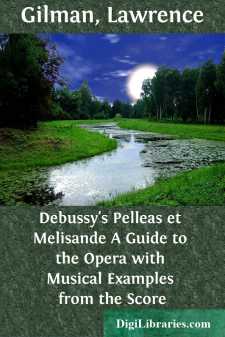Categories
- Antiques & Collectibles 13
- Architecture 36
- Art 48
- Bibles 22
- Biography & Autobiography 813
- Body, Mind & Spirit 142
- Business & Economics 28
- Children's Books 17
- Children's Fiction 14
- Computers 4
- Cooking 94
- Crafts & Hobbies 4
- Drama 346
- Education 46
- Family & Relationships 57
- Fiction 11829
- Games 19
- Gardening 17
- Health & Fitness 34
- History 1377
- House & Home 1
- Humor 147
- Juvenile Fiction 1873
- Juvenile Nonfiction 202
- Language Arts & Disciplines 88
- Law 16
- Literary Collections 686
- Literary Criticism 179
- Mathematics 13
- Medical 41
- Music 40
- Nature 179
- Non-Classifiable 1768
- Performing Arts 7
- Periodicals 1453
- Philosophy 64
- Photography 2
- Poetry 896
- Political Science 203
- Psychology 42
- Reference 154
- Religion 513
- Science 126
- Self-Help 84
- Social Science 81
- Sports & Recreation 34
- Study Aids 3
- Technology & Engineering 59
- Transportation 23
- Travel 463
- True Crime 29
Debussy's Pelleas et Melisande A Guide to the Opera with Musical Examples from the Score
by: Lawrence Gilman
Categories:
Description:
Excerpt
I
With the production at Paris in the spring of 1902 of Claude Debussy's Pelléas et Mélisande, based on the play of Maeterlinck, the history of music turned a new and surprising page. "It is necessary," declared an acute French critic, M. Jean Marnold, writing shortly after the event, "to go back perhaps to Tristan to find in the opera house an event so important in certain respects for the evolution of musical art." The assertion strikes one to-day, five years after, as, if anything, over-cautious. Pelléas et Mélisande exhibited not simply a new manner of writing opera, but a new kind of music—a new way of evolving and combining tones, a new order of harmonic, melodic and rhythmic structure. The style of it was absolutely new and absolutely distinctive: the thing had never been done before, save, in a lesser degree, by Debussy himself in his then little known earlier work. Prior to the appearance of Pelléas et Mélisande, he had put forth, without appreciably disturbing the musical waters, all of the extraordinary and individual music with which his fame is now associated, except the three orchestral "sketches," La Mer (composed in 1903-1905 and published in the latter year), the piano pieces Estampes (1903), and Images, Masques, l'Île joyeuse (1905), and a few songs. Certain audiences in Paris had heard, nine years before, his setting of Rossetti's "Blessed Damozel" (La Demoiselle Élue), a "lyric poem" for two solo voices, female chorus, and orchestra; in the same year (1893) his string quartet was played by Ysaÿe and his associates; in 1894 his Prélude à l'Après-midi d'un Faune was produced at a concert of the National Society of Music; the first two Nocturnes for orchestra, Nuages and Fêtes, were played at a Lamoureux concert in 1900; the third, Sirènes, was performed with the others in the following year. Yet it was not until Pelléas et Mélisande was produced at the Opéra-Comique in April, 1902, that his work began seriously to be reckoned with outside of the small and inquisitive public, in Paris and elsewhere, that had known and valued—or execrated—it.
In this score Debussy went far beyond the point to which his methods had previously led him. It was, for all who heard it or came to know it, a revelation of the possibilities of tonal effect—this dim and wavering and elusive music, with its infinitely subtle gradations, its gossamer fineness of texture, its delicate sonorities, its strange and echoing dissonances, its singular richness of mood, its shadowy beauty, its exquisite and elaborate art—this music which drifted before the senses like iridescent vapor, suffused with rich lights, pervasive, imponderable, evanescent. It was music at once naïve and complex, innocent and impassioned, fragile and sonorous. It spoke with an accent unmistakably grave and sincere; yet it spoke without emphasis: indirectly, flexibly, with fluid and unpredictable expression. It was eloquent beyond denial, yet its reticence, its economy of gesture, were extreme—were, indeed, the very negation of emphasis. Is it strange that such music—hesitant, evasive, dream-filled, strangely ecstatic, with its wistful and twilight loveliness, its blended subtlety and simplicity—should have been as difficult to trace to any definite source as it was, for the general, immensely astonishing and unexpected? There was nothing like it to be found in Wagner, or in his more conspicuous and triumphant successors—in, so to speak, the direct and royal line. Richard Strauss was, clearly, not writing in that manner; nor were the brother musicians of Debussy in his own France; nor, quite as obviously, were the Russians. The immediate effect of its strangeness and newness was, of course, to direct the attention of the larger world of music, within Paris and without, to the artistic personality and the previous attainments of the man who had surprisingly put forth such incommensurable music.
Achille Claude Debussy was born at St. Germain-en-Laye (Seine-et-Oise), France, August 22, 1862. He was still a youth when he entered the Paris Conservatory, where he studied harmony under Lavignac, composition under Guiraud, and piano playing with Marmontel....



